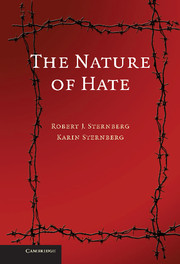Book contents
- Frontmatter
- Contents
- Preface
- 1 The Problem: The Role of Hate in the World
- 2 Definitions and Theories of Hate
- 3 The Duplex Theory of Hate I: The Triangular Theory of the Structure of Hate
- 4 The Duplex Theory of Hate II: A Story-Based Theory of the Development of Hate
- 5 Interpersonal Relationships – Love–Hate
- 6 The Role of Propaganda in Instigating Hate
- 7 Application of the Duplex Theory of Hate to Massacres, Genocide, and Terrorism
- 8 Are There Any Cures for Hate?
- Appendix: Triangular Hate Scale
- References
- Author Index
- Subject Index
- Figure Credits
7 - Application of the Duplex Theory of Hate to Massacres, Genocide, and Terrorism
Published online by Cambridge University Press: 05 June 2012
- Frontmatter
- Contents
- Preface
- 1 The Problem: The Role of Hate in the World
- 2 Definitions and Theories of Hate
- 3 The Duplex Theory of Hate I: The Triangular Theory of the Structure of Hate
- 4 The Duplex Theory of Hate II: A Story-Based Theory of the Development of Hate
- 5 Interpersonal Relationships – Love–Hate
- 6 The Role of Propaganda in Instigating Hate
- 7 Application of the Duplex Theory of Hate to Massacres, Genocide, and Terrorism
- 8 Are There Any Cures for Hate?
- Appendix: Triangular Hate Scale
- References
- Author Index
- Subject Index
- Figure Credits
Summary
The twentieth century was a banner century for genocides and massacres, but the banner it displayed was not a proud one. This chapter deals with hate in the context of terrorism and genocide. It is split up into two sections. The first one deals with a single individual who became a terrorist, Mohamed Atta. We first examine the life of Mohamed Atta, one of the masterminds and executors of the terror attacks of September 11, 2001, and analyze his motivation in light of the duplex theory of hate. We have chosen Atta not only because he was a leader of one of the most, and perhaps the most, spectacular terrorist attacks of recent years, but also because the most information is available about him. For better or worse, the lives of most terrorists are shrouded in secrecy, and so it is difficult to learn much about their lives, and even more difficult to learn much about their minds. Second, we turn from the consideration of an individual and his motivations to group processes and examine, from the viewpoint of the duplex theory, what role hate can play in genocide. More specifically, we deal with the genocide that took place under the Khmer Rouge in Cambodia from 1975 to 1979. Here we examine how the Khmer Rouge could instill enough hate in their fellow Khmers to erect the regime of terror that became “Democratic” Kampuchea.
- Type
- Chapter
- Information
- The Nature of Hate , pp. 165 - 196Publisher: Cambridge University PressPrint publication year: 2008



